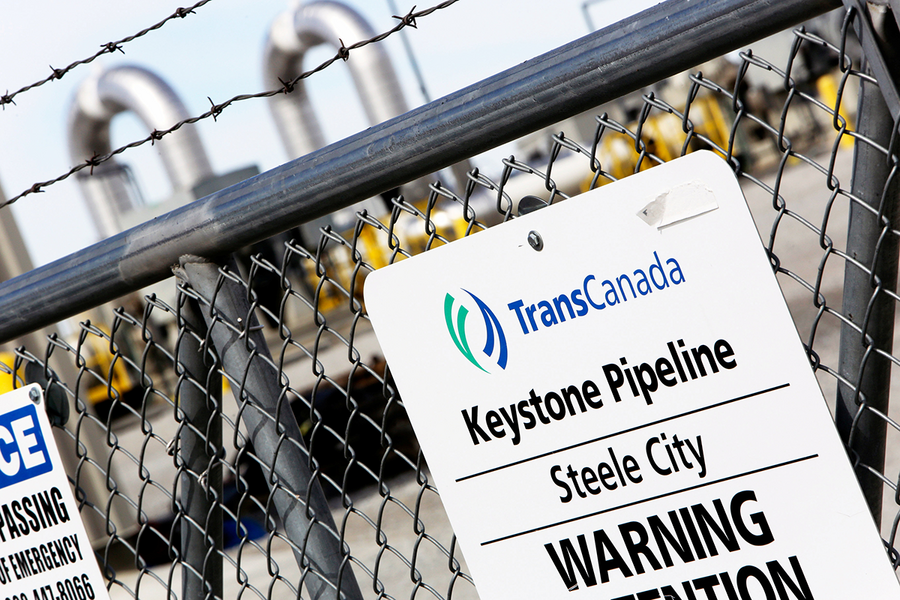What’s next for the Keystone XL pipeline?
Loading...
The Keystone XL pipleine project has been in the works since 2008, but it looked as if the last leg of it would never get built, after then-President Barack Obama rejected the permit application in 2015. However, the Trump administration reversed that decision in March, setting in motion again the process of local reviews.
What’s left to build?
The “XL” would form the hypotenuse of a “Keystone” triangle (see map), running 1,179 miles from Hardisty, Alberta, to Steele City, Neb. There, it would connect with two existing Keystone lines that are already funneling crude to refineries in Illinois, Oklahoma, and Texas.
But the international leg is facing formal challenges in two main places: in Nebraska, where the state’s Public Service Commission has to approve TransCanada’s controversial plans for the pipeline’s route through the state; and in Montana, where three separate lawsuits have been filed in federal courts by environmental and indigenous groups that are seeking to halt construction.
Could opponents kill the project by delaying it in court?
That depends. Dragging out approval from the Public Service Commission is part of the opposition’s strategy in Nebraska, a state that since 2011 has seen pitched battles over the pipeline. Public hearings where landowners, representatives from the Ponca Tribe, and environmentalists will make their case for rejecting the proposed route are slated to begin in August, and most analysts expect the panel’s review to take a year at a minimum.
There’s plenty of reason to expect the commission – a five-member elected panel made up of four Republicans and one Democrat – to ultimately sign off on the proposal. Voters in the traditionally conservative state have consistently favored the project, and the Republican governor has pushed for approval.
But some opponents are making a case that could resonate with business-minded conservatives. They warn that oil leaks could pollute the Ogallala Aquifer, the source of about 80 percent of the state’s drinking water – and about a third of the water tapped for irrigation by the powerful agricultural industry. Also, landowners whose property lies in the path of the proposed pipeline are contesting TransCanada’s claim of eminent domain, arguing that the real benefits of the project would accrue not with Nebraskans but with a foreign corporation.
Bold Nebraska is an opposition group that is pushing for Trans-Canada to alter the route so that it runs parallel to an existing pipeline in eastern Nebraska – and away from the Nebraska Sandhills ecosystem. The group says if it fails to convince the commission, it’ll file lawsuits and mobilize protesters.
“Sometimes, these cases can go on for several years,” says Deborah Ann Sivas, a Stanford professor of environmental law who has litigated high-profile challenges on behalf of environmentalists. “If they want to tie things up in litigation, it might be two to three years to get through an appeal.”
Will there be standoffs with protesters?
Indigenous-led activist groups such as the Indigenous Environmental Network (IEN) are promising to set up encampments along the path of the proposed pipeline. Last year’s well-
publicized protests against the Dakota Access pipeline – another project, which has been slated to pass near the Standing Rock Sioux Reservation in North Dakota – might serve as a blueprint.
But at the moment, courts are the main stage. IEN and other environmental and indigenous activist groups that have filed suits in Montana are seeking to get the Trump administration’s permit voided. They accuse the State Department of violating the National Environmental Policy Act when it based approval of the pipeline on what they describe as a flawed and out-of-date 2013 department analysis of the project’s environmental and economic impacts.
Amid all the opposition, will TransCanada eventually lose interest?
Some oil analysts have speculated that if the price of oil remains low, the Keystone XL could meet the same fate as a 1,700-mile natural-gas pipeline that was being negotiated in 2008 when Sarah Palin was governor of Alaska. That pipeline was never built, amid a glut of cheap gas from the Lower 48. However, the current low price of oil could actually make the cheaper form of shipment provided by pipelines more attractive to producers.
“At the moment, the price of crude looks favorable for the project,” says Tom Seng, a professor of energy business at the University of Tulsa in Oklahoma.“Let’s face it; there’s a cost,” he adds. “There’s going to be protests against Keystone XL and delays, and delays equal costs. But it’s not going to stop the project.”







